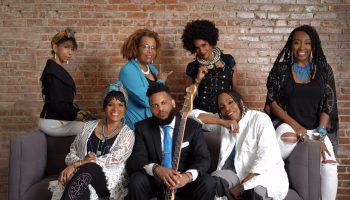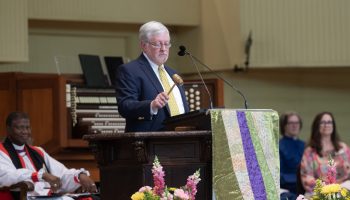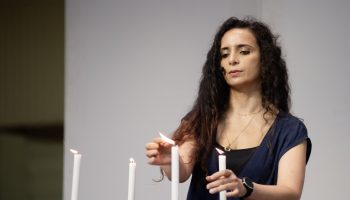
Gabriel Weber
Staff Writer
Reminiscent of a rock band that plays classically composed music, the Grammy- and Emmy-winning ensemble Time for Three returns to Chautauqua for a night of wild celebration and meditative recognition.
The Chautauqua Symphony Orchestra performs under Music Director and Principal Symphonic Conductor Rossen Milanov’s baton alongside Time for Three for composer Kevin Puts’ “Contact” at 8:15 p.m. Saturday in the Amphitheater. The CSO, without the ensemble, will also be performing Zoltán Kodály’s “Dances of Galánta” and Antonín Dvořák’s Selections from Slavonic Dances, Op. 46.
The members of Time for Three — violinists Nicolas “Nick” Kendall and Charles Yang and double bassist Ranaan Meyer — defy convention in genre and through form, as all members are vocalists on top of musicians. Milanov and the musicians in Time for Three have known each other for quite some time and have collaborated often.
“When you have a long lasting friendship with somebody and you’re doing something in a professional setting, there’s just a lot of things like formalities that just don’t need to happen,” Kendall said. “There’s an openness, casualness and understanding of each other because of the deep respect for each other that just allows for the mood to be what it should always be, which is fun, explorative and truly collaborative.”
An Eastern European program, “Dances of Galánta” and “Selections from Slavonic Dances” complement the Bulgarian rhythms in “Contact” as they’re all connected through folk style. Milanov feels both inspired and nostalgic that he can present a slice of his musical background to Chautauqua.
“Contact” is a concerto written for Time for Three that was supposed to premiere in 2020, until the COVID-19 pandemic struck. When the trio was given more time to revise the work with Puts, the piece started to take on the idea of the lack of contact and how the fragility of the human race.
“I think that every time I’ve done it, the audience really goes wild; it’s one of the most successful, sort of, triple concertos in the repertoire,” Milanov said.
Kendall felt inspired when he listened to an NPR podcast by a retired astronaut who was recalling what Earth looked like from space. At the same time, Kendall was impacted by the cultural reckoning that the United States was going through.
“We were going through a lot as a nation, and we on Earth felt so much pain,” Kendall said. “It was just a confusing time, but it was really cool to hear this astronaut’s perspective and how it plays into everything in life. You have to have perspective on what you’re doing, and it gives balance.”
There are four movements total: “The Call,” “Codes,” “Contact” and “Convivium.” Opening with a perfect three-part harmony, Kendall said, Puts imagined what this moment in time would sound like if opened up from a time capsule that was sent into space, and he repeats that theme throughout the work.
“Codes” is an energetic jam session, Kendall said, with little rhythm messages and patterns passed between the soloists and the orchestra. “Contact” denotes the loss that was felt during that time, akin to floating without a tether in outer space while also serving as a reminder as to why human connection is so beautiful.
“Convivium” utilizes a pair of wild Bulgarian folk dances for a truly joyous affair. As Milanov is from Bulgaria, when he first heard the piece, he couldn’t believe that it was written by an American who didn’t hail from the region, since it is made up of these incredibly complex compound measures that require deep intentionality to understand.
“Puts used that as a way to signify community, the joy of being together as a human race and how we have so much more in common than we do apart. It’s a big party at the end,” Kendall said. “At the very end, the orchestra recounts that opening call melody in a really, really stunning and beautiful way. The whole orchestra sings that last part, and it’s suddenly like there’s a choir on stage. It kind of wraps up with this huge climactic moment — it’s a pretty amazing piece.”
A great work of art, Kendall said, leaves room for spontaneity and interpretation.
“Everybody can participate and has to participate in a beautiful way. The thing is a living, breathing thing, so we can never come in just thinking it’s going to be a predictable experience — which is so cool. It really allows for creativity,” Kendall said. “When there’s between 60 to 80 musicians we’re all, on a human level, communicating with each other and sensing each other. That vibe is palpable, and there’s nothing like that.”




